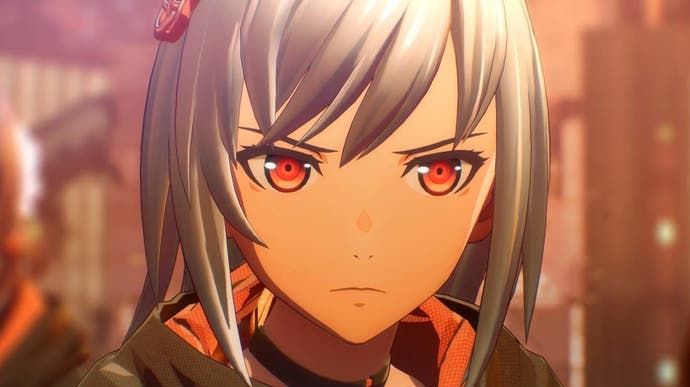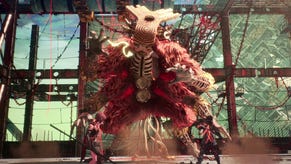Scarlet Nexus: Unreal Engine 4 deployed to excellent effect on PS5 and Xbox Series consoles
Impressive visuals that could easily work on the printed page.
Welcome to Suoh City - the starting point of Scarlet Nexus, and the focus of our very latest tech analysis. Built on Unreal Engine 4, Scarlet Nexus - and in particular this opening locale - presents us with an alternate reality that blends traditional Japanese elements like shinto shrines with the futuristic tech of its high streets. Taking one of two selectable characters through its adventure, here we have an anime-inflected action RPG that has you defeating enemies known as The Others - mutant creatures - via combo-driven combat in a futuristic world where superpowers are the norm. Gameplay is served up at 60 frames per second on PlayStation 5, Xbox Series X and S. But how close are we getting to a locked 4K resolution at 60fps, and how does Series S slot in?
Developed by key members of the Tales series, Scarlet Nexus' most fascinating draw is easily its visual style. The backdrop detailing of Suoh, and the ruined outskirts beyond it, is generously plotted with detail. The style, especially in the Kikuchiba Merchant City later on, draws clear inspiration from classic anime works like Akira, with thin linework helping to etch out patterns of battered circuitry, distant city skylines, all tinged with a green hue. Often it's presented in a way that could easily sit on the printed page. The setting sets up a scenario where mankind has tapped into special abilities via a substance found in the mind, while of course, it's far from a utopia. Rather, mutated creatures known as the Others threaten to disrupt the society built around all these new-found powers. And so it's up to you and your squad to scout out and battle these creatures wherever they pop up.
The setup is simple and well handled. The combat too is well explained, but not without fault. Over the first three hours, expect to dismiss a lot of tutorial prompts. It's gradually paced, where new moves are drip-fed via an ability unlock menu. But honestly, it's easy to be put off by the combat to begin with: even basic mechanics like quick recovery after being hit, or double-jumping are gated off until you reach higher levels. Namco Bandai Studios' choice to strip each character's moves down in order to offer an upgrade path means that combat starts off as being rather tedious. You do build satisfying momentum later on: mid-air combo strings, well-timed dodges and even psychokinesis powers are added to the mix - it just takes some time to get to the good stuff.
Provided you're ready to put time in, Scarlet Nexus has a lot going for it. The visual style, even the music are standout - but as far as the image quality goes, the experience varies based on your console of choice. Which brings us the visual comparisons: PS5 vs Xbox Series X up first being the two premiere ways to play the game on console. The truth is, of the new consoles, there's little to differentiate them. The core rendering setup is a match on Unreal Engine 4. Each machine gets the exact same settings for world detail, and even pop-in is matched as you traverse the big city.
The game looks clean - surprisingly so - bearing in mind that dynamic resolution scaling is in play, but UE4's temporal upscaling solution is very, very good. Settle on a still frame and the image resolves at 3840x2160 for each console - intelligently using previous frames to construct a sharper image. It works brilliantly. In truth though? PS5 and Series X are each adjusting their true resolutions to suit GPU load. Find a taxing moment - such as a finishing move where the camera cuts to a new viewpoint, and you'll track the actual, raw pixel structure. For PS5 and Series X, this shows a lower bound figure at around 2560x1440 on each - with very rare signs of a lower number. In general though, you get a range of between a native 1440p and 4K. All told in motion, UE4's reconstruction looks very, very good.
What of Series S? Well expectedly, there's a drop in image quality here, especially next to its more powerful sibling, Series X. In terms of the visual settings it's still pushing all the same features though, which is impressive. Textures look blurrier owing to the lower image resolution and downgraded texture filtering, but otherwise it's a match. Resolution-wise, we're down to 2560x1440 as the maximum target on Series S - more or less the promised spec for the machine. However, if we dissect the image at stress points, native pixel counts come in at a range of 900p lowest, up to 1296p in typical play.

All round it's impossible to overlook the extra scaling on a 4K TV here; the image will look blurrier - especially so in battle, where resolution takes the biggest hit. However, the game should look really nice on a 1080p screen. Perhaps the bigger point is the state of frame-rate; Series S targets 60fps much like PS5 and Series X, but seems to have some issues locking it down perfectly. In stressful scenes with the game reaching its minimum internal resolution, frames are dropped, meaning you're playing at 50-60fps in battle and certain cutscenes, but it's much closer to the target overall during traversal.
Xbox Series X gets much closer to its performance targets across the board, with a nigh-on lock to 60fps during traversal, but with brief frame-rate drops in battle during big showcase moves. On the whole Series X holds up really well; especially given it's targeting a 4K image too. It's just shy of the perfect result which I'd expected, with even cutscenes dropping into the 50s at points too. Meanwhile, it's a case of further refinement on PS5 - smoother cutscenes, a closer (but still not perfect) lock to 60fps during combat. In effect, PS5 and Series X are very much alike - but frame-rate drops are just a touch less aggressive on the Sony system. Thankfully, both Xbox consoles can rely on VRR to smooth away the problems in a way that PlayStation 5 cannot.
Loading times? Many of Scarlet Nexus' areas demand a loading screen, but neither console takes especially long. For the construction site, for example, PS5 comes in at 6.5 seconds, next to the 7.3 on Series X. And if we take our test over to the Underground facility, we're looking at 5.2 on PS5 versus 5.6 on the flagship Xbox. Slim margins clearly, and acceptable on both sides. PlayStation interestingly has a small lead each time, but really, it's not enough to notice outside of comparisons here.
Summing up, Scarlet Nexus stands out for its stylised anime visuals and - patience allowing - a combat system that grows with options as you play. The world is one of the more imaginative I've seen rendered on Unreal Engine 4 and this all scales well to the new wave of consoles, especially with each being delivered at 60fps. The surprise is that even PS5 an Series X can't 100 per cent push 60fps during battles. The hope is that Namco Bandai Studios can delve in to tighten up delivery on each down the line, and especially Series S.
Performance quibbles aside the star of the show remains the art direction and music. I honestly didn't know what to expect booting the game up first time and, on the whole, I ended my capture session for this tech analysis pleasantly surprised. Scarlet Nexus is bookmarked as one of the bigger surprises of 2021 for me so far. It should strike a harmonising chord for RPG and anime enthusiasts alike, even with the slight misgivings in its technical delivery right now.







